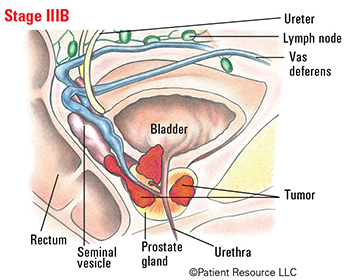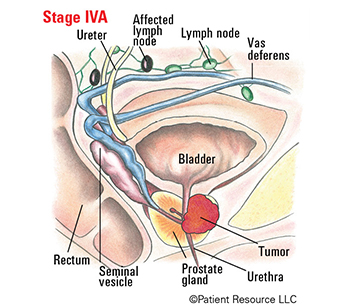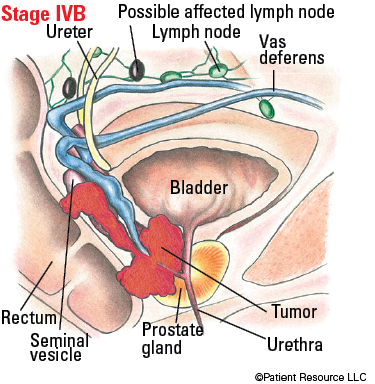Advanced Prostate Cancer
Staging
As with any type of cancer, doctors use staging information to plan your treatment and to help predict the likely outcome (prognosis) of the therapy you choose. In addition to the advanced stages, information about each of the other stages is also included to help you better understand how the disease can progress over time. Discussing your stage and your treatment options with your doctors will help you select the best plan for your specific type of cancer.
When cancer cells have spread from the prostate into the lymphatic system, blood, bones or other organs, the disease is considered advanced and may require a much more aggressive treatment plan.
Prostate cancer stages are based on the tumor, node, metastasis (TNM) system developed by the American Joint Committee on Cancer (Table 1). The doctor who evaluates the diagnostic tests will assign a clinical stage based on the evaluation of one or more of the following: a prostate biopsy sample, a physical examination and the results of imaging studies (bone scans, MRI scans and CT scans). These tests allow your doctor to determine the size and location of the tumor(s) (T category), and to see whether cancer has spread to nearby lymph nodes (N category) or other parts of the body (M category).
Table 1. TNM system for classifying prostate cancer
| Classification | Definition |
| Tumor (T) | |
| TX | Primary tumor cannot be assessed. |
| T0 | No evidence of primary tumor. |
| T1 | Clinically inapparent (produces no signs or symptoms) tumor that is not palpable (noticeable by touch). |
| T1a | Tumor incidental histologic finding in 5 percent or less of tissue resected. |
| T1b | Tumor incidental histologic finding in more than 5 percent of tissue resected. |
| T1c | Tumor identified by needle biopsy found in one or both sides, but not palpable (noticeable by touch). |
| T2 | Tumor is palpable (noticeable by touch) and confined within prostate. |
| T2a | Tumor involves one-half of one side (one prostate lobe) or less. |
| T2b | Tumor involves more than one-half of one side (one prostate lobe) but not both sides (both lobes). |
| T2c | Tumor involves both sides (prostate lobes). |
| T3 | Extraprostatic tumor (tumor extends beyond the prostate gland) that is not fixed or does not invade adjacent structures. |
| T3a | Extraprostatic extension (tumor extends beyond the prostate gland) (unilateral or bilateral). |
| T3b | Tumor invades seminal vesicle(s) (gland on each side of the bladder). |
| T4 | Tumor is fixed or invades adjacent structures other than seminal vesicles such as external sphincter, rectum, bladder, levator muscles and/or pelvic wall. |
| Node (N) | |
| NX | Regional nodes were not assessed. |
| N0 | No positive regional nodes. |
| N1 | Metastases in regional node(s). |
| Metastasis (M) | |
| M0 | No distant metastasis. |
| M1 | Distant metastasis. |
| M1a | Nonregional lymph node(s). |
| M1b | Bone(s). |
| M1c | Other site(s) with or without bone disease. |
Table 2. AJCC Prognostic Stage Groups
| Group/stage | TNM classification | Gleason grade | Prostate-specific antigen (PSA) level |
| IIIA | T1-2, N0, M0 | 1-4 | Greater than or equal to 20 |
| IIIB | T3-4, N0, M0 | 1-4 | Any level |
| IIIC | Any T, N0, M0 | 5 | Any level |
| IVA |
Any T, N1, M0
|
Any grade
|
Any level
|
| IVB |
Any T, Any N, M1
|
Any grade
|
Any level
|
If your prostate was removed surgically, a pathologist will examine it and assign a more precise pathologic stage (Table 2), which will help determine your prognosis and help you choose a personalized plan that works best for your cancer.
The pathologist will also examine a sample from the prostate biopsy under the microscope and assign a grade to the tumor. This grade, known as the Gleason score, ranges from 2 to 10. To determine the Gleason score, the cancerous tissue patterns are given a grade, from one (non-aggressive) to five (very aggressive). The pathologist will assign a low score when the tumor looks more like normal prostate tissue and higher scores when the cancer looks “less differentiated,” or less like normal tissue. Because one tumor may contain multiple grades, the two most dominant grades in the tumor sample are added together. If the most common grade within the tumor is 3 and the second most common type is 2, then the Gleason score is 5. The higher the Gleason score, the more likely the tumor is to spread:
- Gleason 6 – Tumor tissue is well differentiated, less aggressive and more likely to grow slowly.
- Gleason 7 – Tumor tissue is somewhat differentiated, moderately aggressive and likely to grow, but it is less likely to spread quickly.
- Gleason 8 to 10 – Tumor tissue is poorly differentiated or undifferentiated, very aggressive and likely to grow quickly and very likely to spread.
Along with your stage, your doctor will consider your Gleason score and your initial PSA level (before surgery or radiation) when planning the best treatment for you.
Stages III and IV prostate cancer are considered to be advanced. In these stages, the tumor extends outside of the prostate into nearby tissues, lymph nodes, organs and/or bones.
Stage III is also known as locally advanced prostate cancer, as it has extended beyond the prostate but is still confined to the “local” area of the prostate. Stage IV cancer may be either regional disease, which means the cancer has spread to nearby lymph nodes but has not spread to other parts of the body, or distant disease, which means the cancer has spread to distant lymph nodes, bone or other organs.
Most cases of advanced prostate cancer begin as early-stage cancer but spread to other areas, such as the bladder, rectum, bones, lungs or liver. Once cells have migrated to other organs and tissues, the cancer is considered to be "advanced," which is almost always signaled by a rising PSA level after the initial treatment. Some patients may be diagnosed with advanced prostate cancer at the original diagnosis.




Talk to your doctor to learn more about your stage and the results of your biopsy and other diagnostic tests so you can work with your health care team to plan a treatment regimen that’s appropriate for you. Don’t be afraid to ask for copies of test results and ask questions about the staging process so you can fully understand how it will affect your care.



